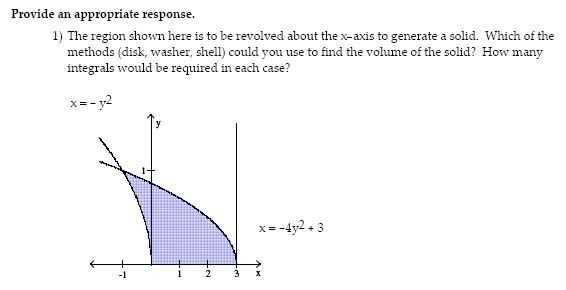Shutterbug424
New member
- Joined
- Oct 16, 2008
- Messages
- 40

I got the volume using the shell method as being \(\displaystyle {\frac{{3\pi}}{{ 2}}}\)
When I used the washer method, I took 2 integrals.
This was the first one:
\(\displaystyle V = \pi \int\limits_{ - 1}^0 {\left( {\sqrt {\frac{{x - 3}}{{ - 4}}} } \right)} ^2 - \left( { \sqrt { - x}} \right)^2 dx\)
\(\displaystyle = \pi \int\limits_{ - 1}^0 {\frac{x}{{ - 4}}} + \frac{3}{4} + x dx\)
When I evaluate it, I get a negative answer which couldn't possibly be right. I noticed when I switch some of the positive and negative signs, I get the answer I need to get,
which is \(\displaystyle \frac{{3\pi }}{8}\)
The second equation I evaluated was:
\(\displaystyle V = \pi \int\limits_0^3 {\left( {\sqrt {\frac{{x - 3}}{{ - 4}}} } \right)} ^2 dx\)
I found this to be \(\displaystyle \frac{{9\pi }}{8}\)
When I add \(\displaystyle \frac{{3\pi }}{8}\) and \(\displaystyle \frac{{9\pi }}{8}\), I get \(\displaystyle \frac{{3\pi }}{2}\) (which I believe to be the correct answer).
My question is, where did I go wrong in the first equation that it didn't exactly work out to be \(\displaystyle \frac{{3\pi }}{8}\)?
